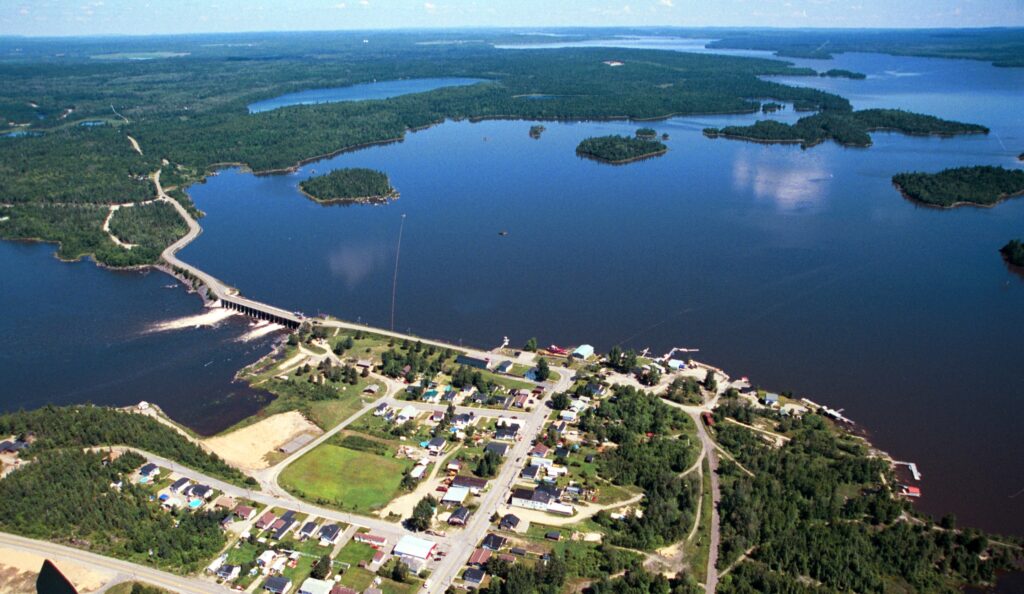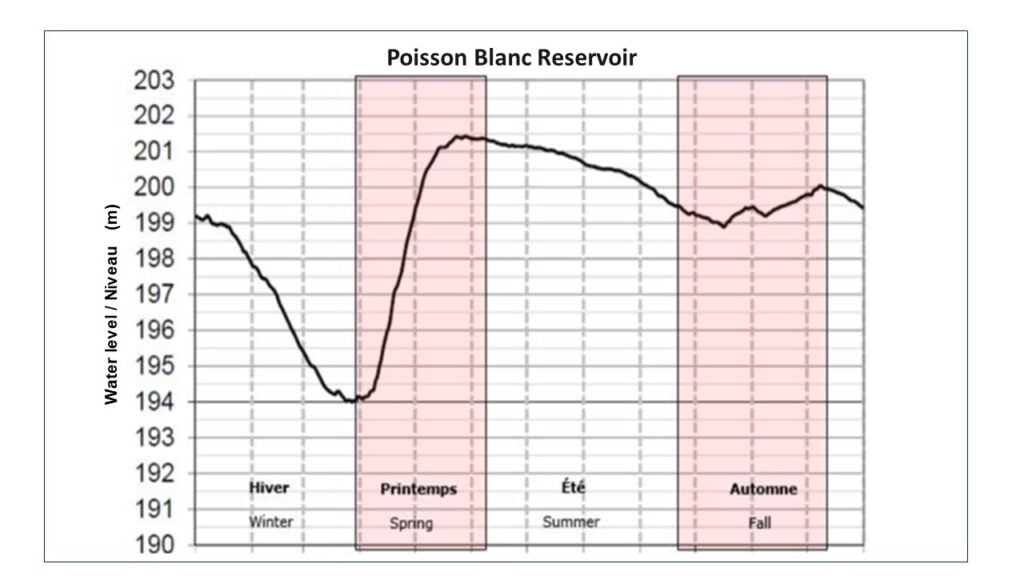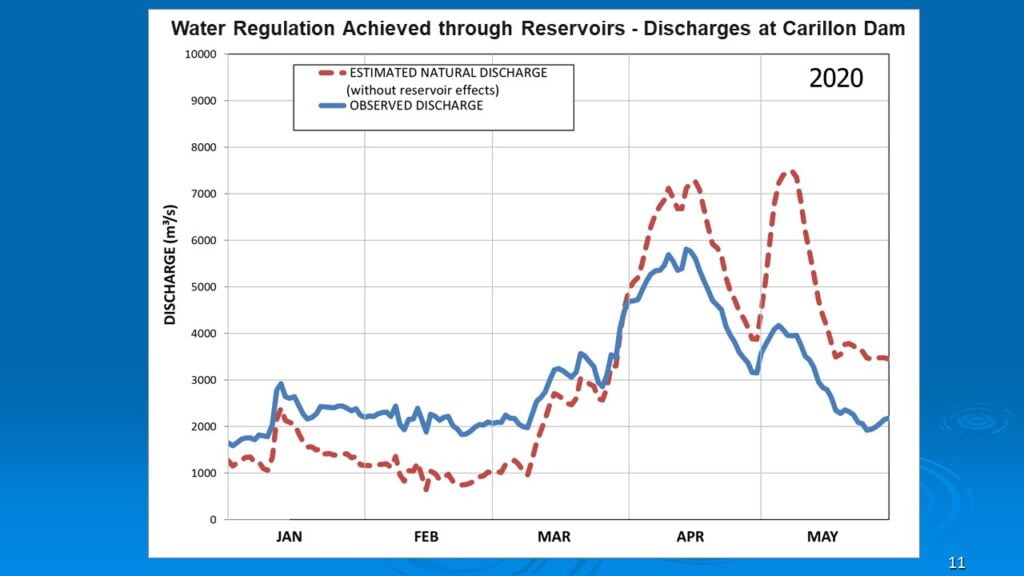The Ottawa River Basin and its Reservoirs
In the early years, the Ottawa River was used mainly for navigational purposes. European explorers and fur traders used this route to the interior of the continent and a part of the inland route between Montreal and Kingston. Later, it carried rafts of logs to mills for processing.
The first reservoirs on the river, namely the Timiskaming, Quinze and Kipawa reservoirs, were built between 1911 and 1914 to aid navigation, increase low flows during dry years and provide some flood mitigation. Later, more reservoirs were established with hydroelectric energy production as their primary purpose.
Rapid urbanization in the 20th century and changes in the needs of the basin’s population changed the use of the river. Today’s biggest needs are for hydroelectric energy generation, domestic water supply, effluent dilution (wastewater), recreational activities and flood mitigation. Environmental protection has also increasingly become a priority. Fortunately, all these uses of the water flow are compatible. The storage and release of water in reservoirs serve many benefits beyond power generation.
Characteristics of the Basin
From its source east of the Dozois Reservoir to its confluence with the St. Lawrence River, the Ottawa River has a length of more than 1,130 kilometres. For most of its length, it forms the boundary between the provinces of Ontario and Québec. Its basin covers a total area of 146,300 square kilometres, 65% of which is in Québec and 35% in Ontario.
The Ottawa River basin has a dense hydrographic network encompassing 19 tributaries with basins that are over 2,000 square kilometres in drainage area. On the Quebec side (left bank), major tributaries include the Gatineau, du Lièvre, Kipawa, and Rouge rivers. On the Ontario side (right bank), major tributaries include the Madawaska, Montréal, Blanche and Petawawa rivers. The largest of the tributaries, both in terms of length and discharge volume is the Gatineau River.
Principal Reservoirs in the Ottawa River Basin
There are currently thirteen principal reservoirs within the basin. Each of these reservoirs have the capacity to store more than 200 million cubic metres of water. That is larger than 80,000 Olympic-sized swimming pools. The principal reservoirs of the Ottawa River basin are presented in the table and figure below.
| RIVER | RESERVOIR | CAPACITY* million m3 |
|---|---|---|
| Outaouais | Dozois (1) | 1,863 |
| Decelles-Rapid VII (2) | 371 | |
| Quinze (3) | 1,308 | |
| Timiskaming (4) | 1,217 | |
| des Joachims (5) | 229 | |
| Montreal | Lady Evelyn (6) | 308 |
| Kipawa | Kipawa (7) | 673 |
| Madawaska | Bark Lake (8) | 374 |
| Gatineau | Cabonga (9) | 1,565 |
| Baskatong (10) | 3,049 | |
| Lievre | Mitchinamecus (11) | 554 |
| Kiamika (12) | 379 | |
| Poisson Blanc (13) | 625 |

The Spring Freshet
Due to the basin’s size, shape and topography, meteorological conditions vary from place to place. This results in differing responses in water flow from different tributaries. Varying response times from major tributaries combine to produce two distinct freshet peaks. These two freshet peaks are typically about three weeks apart.
The first freshet peak in the Ottawa River comes from unregulated flows from the southern tributaries. The second peak, which is partially regulated, comes from a combination of high flows from the tributaries of the north shore and flows from headwater areas. The first peak is generally the lesser of the two.
Monitoring of hydrometeorological conditions in the basin helps the forecast of high and low water events. However, the current state of meteorological, scientific and technical knowledge still leaves a great level of uncertainty in forecasts.
The Flood Situation
In years where spring runoff is significant, it is not possible to prevent flooding. Costs associated with flooding are not only monetary, but also have a human element. Families must sometimes leave their homes for temporary housing until the floodwaters recede, while business and recreational activities are also impacted.
There are no simple solutions to the flood problems of the Ottawa River basin. For example, flows in the southern portion of the basin are unregulated and storage in the principal reservoirs has a limited effect on the first freshet peak.
The second peak, about three weeks later, is strongly influenced by reservoir operations and capacity. Normal operations at the principal reservoirs can ensure that a significant portion of the spring runoff from the northern parts of the basin is stored. This always reduces the severity of both spring peaks.
The thirteen principal reservoirs, for example the Des Quinze reservoir shown in the figure below, are subject to integrated management under the policies of the Planning Board.

These reservoirs are owned and operated by four agencies. These agencies make up the Ottawa River Regulating Committee. Integrated management means combining the reservoir operation decision-making processes of these four agencies into one process. This single process provides a common information and decision-making support system.
This collaboration allows operators to:
- agree on the effects weather events (e.g. a thaw or a heavy rainfall event) will have on river conditions,
- see the effects of their flow regulation decisions on downstream river flows and levels,
- make optimal adjustments to flow released from reservoirs on a day-to-day basis.
The goal of this provincial-federal collaboration is to mitigate the impacts of floods and droughts.
The Planning Board is not a “control board”. It cannot dictate how operators manage their reservoirs. Each operator remains responsible for the operational strategies and decisions at their facilities.
During the spring freshet, there is a daily exchange of data between the agencies of the Committee and the Secretariat. This also happens during other unusually high flow events. The data received from the agencies includes real-time water level and flow data and measurements of snowpack conditions. This data is collected from remote sensing equipment located throughout the basin. Operators of the principal reservoirs also send details of the operations they intend to carry out at their structures over the next ten days.
A hydrologic model of the basin is used to predict the quantity of runoff that will flow to the river based on forecast precipitation and temperatures. The expected quantity of water to flow into a stream from the surrounding basin is called ‘inflow’.
The Secretariat combines data for current river conditions and details of intended operations, along with forecast inflows for all tributaries and areas draining to the Ottawa River. This combined data serves as input to flow routing models. Flow routing models predict water levels and flows at different points throughout the basin. To learn more about the models used by the Committee, click here.
The model results are evaluated by the Committee and the Secretariat and are discussed during conference calls or meetings during critical periods. The goal of the discussion is to work together to manage water and, if levels in the river system are forecasted to exceed flood thresholds, determine what actions may be required to reduce the impacts of flooding. This process is repeated every day during high water events and once a week at other times. In 2019, the Committee held more than fifty conference calls during the spring freshet.
During periods of low flow conditions, a weekly exchange of information is typically carried out to integrate the management of principal reservoirs. Conditions during low flow periods change very slowly. This is why it is not necessary to meet on a daily basis. To learn more about low flow or drought conditions click here.
Each of the four agencies is responsible for the management of their own facilities and principal reservoirs.
Principal Reservoirs
In general, the water management cycle of the principal reservoirs in the Ottawa River basin follows the operation shown in the figure below.
- Fall – The principal reservoirs are typically full after regulating the basin’s runoff during the fall period.
- Winter – The principal reservoirs water levels are progressively lowered during the winter period. Most years, the goal is to empty the reservoirs prior to the onset of freshet. This is done from approximately mid-December to the end of March. Water that was stored in the principal reservoirs flows out of the river system before increasing natural snowmelt runoff can cause flooding to downstream locations or local communities. Note: The Des Joachims reservoir is the smallest of the thirteen principal reservoirs and requires only a few weeks to empty. Des Joachims is emptied every year, typically during the month of March.
- Spring – During the freshet, the principal reservoirs help reduce flooding in downstream locations along the river and tributaries. This is done by storing large volumes of water and reducing flows in the lower river sections. This mitigates the downstream flooding.
- Summer- During the summer period, water is managed to maintain relatively stable water levels and mitigate the impacts of droughts when required.

Run-of-river Facilities
Most of the facilities that are located along the mainstem of the Ottawa River between Lake Timiskaming and the Deux-Montagnes area have less than 200 million cubic metres of storage and are therefore not referred to as principal reservoirs. The Planning Board sometimes refers to these facilities as run-of-river facilities. Examples of run-of-river facilities include the Chats Falls facility near Arnprior and the Carillon dam near Hawkesbury and Grenville. They are a type of hydroelectric facility where little or no water is stored compared to the volume of water flowing in the river during the spring freshet. To know more about run-of-river facilities, refer to FAQ 5.
Water Uses
Several uses of water are considered by operators (no specific order of priority): flood and drought impacts mitigation, navigation, environmental protection, hydropower generation, water supply for drinking water, wastewater effluent dilution and recreational and tourism activities. However, safety is always the focus of water management throughout the year and particularly during periods of high flows. It is of note that extremely high water levels such as those experienced during the 2017 and 2019 flood events are inefficient for generating hydropower. For more information about how hydropower generation during high flow and flooding conditions, refer to FAQ H.
Federal and Provincial Requirements
Management of water at the principal reservoirs and other facilities is subject to provincial and federal legislation and regulations. For example, reservoir operators must respect levels and discharges required for environmental protection where they exist. These water management requirements do not apply to every part of the river. Also, some requirements may not apply during the freshet period when high flows make it impossible to maintain them. For example, it may be physically impossible to respect a requirement to maintain the water level below a certain level. To learn more about why it is impossible to lower water levels in some situations, refer to Part C of FAQ 5.
Technologies
Qualified and experienced technical staff do analyses and make decisions about dam management at the reservoirs. However, some processes are automated. For example, these two processes can be automated, but are also under constant supervision:
- the collection and transmission of hydrological data, and
- the operation of some water flow control structures.
Various technologies are used to provide guidance and decision-making support — for example, meteorological and hydrological forecasting models. Modelling and forecasts are ultimately only used as information to inform the decision-making process for the operation of the principal reservoirs.
The regulation of water achieved through the use of the principal reservoirs impacts water levels mainly during the winter and spring periods. The effects of water regulation on Ottawa River river conditions are illustrated at the Carillon dam in the figure below.

In winter time, as the principal reservoirs are progressively emptied, water is released to downstream river reaches. In the figure, this is shown with the observed flows (blue line) being higher than what we estimate they would be naturally (red dashed line). More water in the Ottawa River means that water levels will also be higher.
In spring time, as the principal reservoirs are filled with snowmelt and rainfall runoff, the action of retaining water in the reservoirs prevents it from flowing downstream. This has the effect of reducing flows downstream in the Ottawa River. In the figure, this is shown with the observed flows (blue line) being lower than what we estimate they would be naturally (red dashed line). With flows lower than they would be naturally, water levels in the Ottawa River during the freshet are also reduced compared to natural conditions.
How High can Water Levels be?
During high flow conditions, along the length of Ottawa River, there are no maximum water levels. Approximately 60% of the Ottawa River basin does not have associated reservoir storage which means that water is only partially regulated. Additionally, if spring runoff in the other 40% of the basin (or the regulated portion) exceeds the volume of the principal reservoirs, the excess water will flow downstream in the mainstem of the river. Therefore, the maximum flow in the river system is primarily determined by natural factors, mainly snowmelt, temperature and precipitation. The uncontrolled sectors of the basin often comprise most of the flow in the river during the spring freshet and there is no guarantee that flows will never exceed those of 2019. Having no upper limit for flows means that there is no upper limit for levels. For more information about the factors that contribute to flooding, refer to ‘Collaborative Management’ and FAQ 1. For more information about the specific dams, refer to the ‘General Dam Information’.
During normal flow conditions, water levels in many locations along the main stem of the Ottawa River between Lake Timiskaming and the Carillon dam are influenced by both the Ottawa River flows and hydroelectric facilities. For example, water levels in Lac Coulonge are determined by river flows and the operation of the Bryson dam, and water levels in Chats Lake are determined by flows and the operation of the Chats Lake dam. Maximum and minimum exploitation levels during normal river conditions can be requested directly from the agency that owns the dam.